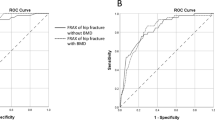Abstract
Purpose
Despite the large number of osteoporosis patients in China, the diagnosis and treatment rates remain low. The Fracture Risk Assessment Tool (FRAX) can be used to effectively evaluate fracture risk. In this study, we explored the Chinese-specific thresholds of FRAX without the T-score.
Methods
In all, 264 postmenopausal women aged > 50 years were randomly recruited from community-medical centers. All subjects completed self-reported questionnaires, BMD measurements, and spinal radiographs. The 10-year hip and major osteoporotic fracture risks were calculated by FRAX. A new threshold for both 10-year hip and major osteoporotic fracture risk was explored with receiver operating characteristic (ROC) curve analysis.
Results
Overall, 92 subjects were diagnosed with osteoporosis. Among them, 14 participants with T-score > − 2.5 were diagnosed with osteoporosis based on clinical fractures. ROC analysis showed the cut-off value of the 10-year hip osteoporotic fracture for detecting osteoporosis was 0.95%, while that of 10-year major osteoporotic fracture was 4.95%. The sensitivity and specificity of the 10-year hip osteoporotic fracture probability for detecting osteoporosis were 0.86 and 0.59, respectively, while the guideline-recommended threshold had a sensitivity of 0.49 and specificity of 0.83. The sensitivity and specificity of the 10-year major osteoporotic fractures with the new threshold were 0.76 and 0.69, respectively, while the recommended threshold had a sensitivity of 0 and specificity of 1.
Conclusion
Current guideline-recommended FRAX thresholds without BMD showed low sensitivity. Therefore, 10-year osteoporotic hip fracture probability ≥ 0.95% and 10-year osteoporotic major fracture probability ≥ 4.95% are recommended as the new thresholds.

Similar content being viewed by others
References
NIH Consensus Development Panel on Osteoporosis Prevention, Diagnosis, and Therapy (2001) Osteoporosis prevention, diagnosis, and therapy. JAMA 285:785–795
Black DM, Rosen CJ (2016) Clinical practice. Postmenopausal Osteoporosis N Engl J Med 374:254–262
Si L, Winzenberg TM, Jiang Q et al (2015) Projection of osteoporosis-related fractures and costs in China: 2010–2050. Osteoporos Int 26:1929–1937
Melton LJ III, Chrischilles EA, Cooper C et al (2005) How many women have osteoporosis? JBMR anniversary classic. JBMR, volume 7, number 9, 1992. J Bone Miner Res 20:886–892
US Preventive Services Task Force, Curry SJ, Krist AH et al (2018) Screening for osteoporosis to prevent fractures: US preventive services task force recommendation statement. JAMA 319:2521–2531
Kanis JA (2008) on behalf of the World Health Organization Scientific Group 2008b Assessment of osteoporosis at the primary healthcare level. Technical Report. WHO Collaborating Centre, University of Sheffield, UK. https://www.sheffield.ac.uk/FRAX/pdfs/WHO_Technical_Report.pdf. Accessed 12 May 2018
Cosman F, de Beur SJ, LeBoff MS et al (2014) Clinician’s guide to prevention and treatment of osteoporosis. Osteoporos Int 25:2359–2381
Chinese Society of Osteoporosis and Bone Mineral Research (2017) Guidelines for the diagnosis and management of primary osteoporosis. Chin J Osteoporos Bone Miner Res 10:413–444. https://doi.org/10.3969/j.issn.1674-2591.2017.05.002
Compston J, Cooper A, Cooper C et al (2017) UK clinical guideline for the prevention and treatment of osteoporosis. Arch Osteoporos 12:43
Liu SY, Huang M, Chen R et al (2019) Comparison of strategies for setting intervention thresholds for Chinese postmenopausal women using the FRAX model. Endocrine 65:200–206
Wang O, Hu Y, Gong S et al (2015) A survey of outcomes and management of patients post fragility fractures in China. Osteoporos Int 26:2631–2640
Sheng Z, Xu K, Ou Y et al (2011) Relationship of body composition with prevalence of osteoporosis in central south Chinese postmenopausal women. Clin Endocrinol (Oxf) 74:319–324
Genant HK, Wu CY, van Kuijk C et al (1993) Vertebral fracture assessment using a semiquantitative technique. J Bone Miner Res 8:1137–1148
Grados F, Roux C, de Vernejoul MC et al (2001) Comparison of four morphometric definitions and a semiquantitative consensus reading for assessing prevalent vertebral fractures. Osteoporos Int 12:716–722
Xia WB, He SL, Xu L et al (2012) Rapidly increasing rates of hip fracture in Beijing, China. J Bone Miner Res 27:125–129
Tian FM, Zhang L, Zhao HY et al (2014) An increase in the incidence of hip fractures in Tangshan, China. Osteoporos Int 25:1321–1325
WHO Study Group (1994) Assessment of fracture risk and its application to screening for postmenopausal osteoporosis. Report of a WHO Study Group. World Health Organ Tech Rep Ser 843:1–129
Kim JW, Koh JM, Park JH et al (2015) Validation of FRAX without BMD: an age-related analysis of the Fifth Korean National Health and Nutrition Examination Survey (KNHANES V-1, 2010). Bone 75:27–31
Oka R, Ohira M, Suzuki S et al (2018) Fracture risk assessment tool (FRAX) and for the diagnosis of osteoporosis in Japanese middle-aged and elderly women: Chiba bone survey. Endocr J 65:193–202
Chen XF, Li XL, Zhang H et al (2014) Were you identified to be at high fracture risk by FRAX(R) before your osteoporotic fracture occurred? Clin Rheumatol 33:693–698
Xu J, Sun M, Wang Z et al (2013) Awareness of osteoporosis and its relationship with calcaneus quantitative ultrasound in a large Chinese community population. Clin Interv Aging 8:789–796
Funding
Zhifeng Sheng received funding from the National Nature Science Foundation of China (81471091 and 81870622), the Hunan Nature Science Foundation (2018JJ2574), and Bethune Charitable Foundation (G-X-2019-1107-3). All other authors received no financial support for the research, authorship, and/or publication of this article.
Author information
Authors and Affiliations
Corresponding author
Ethics declarations
Conflict of interest
The authors declare that they have no conflict of interest.
Ethical approval
All research procedures in this study were in accordance with the ethical standards of institutions and with the 1964 Helsinki declaration and its subsequent amendments.
Informed consent
Informed consent was obtained from all individual participants included in the study.
Additional information
Publisher's Note
Springer Nature remains neutral with regard to jurisdictional claims in published maps and institutional affiliations.
Rights and permissions
About this article
Cite this article
Liu, S., Chen, R., Ding, N. et al. Setting the new FRAX reference threshold without bone mineral density in Chinese postmenopausal women. J Endocrinol Invest 44, 347–352 (2021). https://doi.org/10.1007/s40618-020-01315-4
Received:
Accepted:
Published:
Issue Date:
DOI: https://doi.org/10.1007/s40618-020-01315-4




